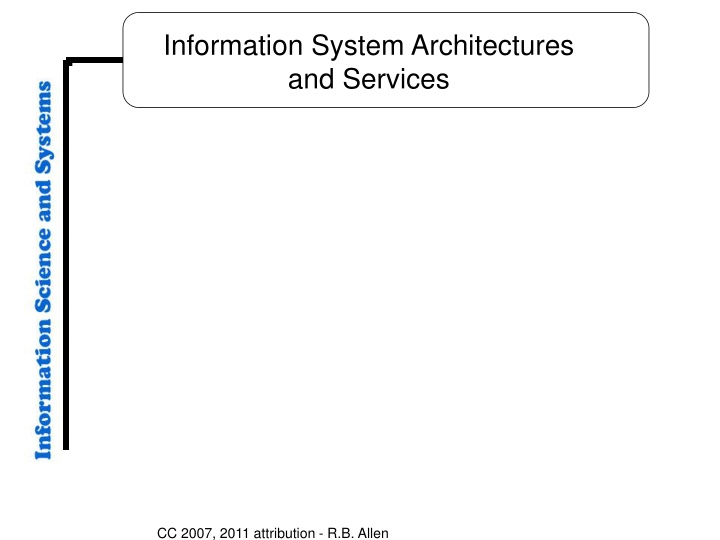
Information System Architectures and Services
Explore the intricate world of information system architectures and services, including the Model-View-Controller framework, managing complexity in distributed systems, service-oriented architectures, information institutions, libraries, and archives. Delve into the importance of information management in society and the essential functions of libraries and archives.
Download Presentation

Please find below an Image/Link to download the presentation.
The content on the website is provided AS IS for your information and personal use only. It may not be sold, licensed, or shared on other websites without obtaining consent from the author. If you encounter any issues during the download, it is possible that the publisher has removed the file from their server.
You are allowed to download the files provided on this website for personal or commercial use, subject to the condition that they are used lawfully. All files are the property of their respective owners.
The content on the website is provided AS IS for your information and personal use only. It may not be sold, licensed, or shared on other websites without obtaining consent from the author.
E N D
Presentation Transcript
Information System Architectures and Services CC 2007, 2011 attribution - R.B. Allen
Architectures The architecture is the relationship of the components of the information system. One useful framework is the Model-View-Controller (MVC) CC 2007, 2011 attribution - R.B. Allen
Managing Complexity with Distributed Systems There s additional complexity when the components of the information system are distributed across several machines in a network. Some approaches for managing complexity: Layering Modularity Interoperability CC 2007, 2011 attribution - R.B. Allen
Service Oriented Architectures (SOA) It s helpful to define complex information systems in terms of the services they provide. We would like to work with architectures which make it easy to implement services. This turns out to fit well with systems analysis and object-oriented design In research environments, this is often implemented with java apache tomcat web server Repositories are content management systems which support services. Digital Libraries, Enterprise Content Management Systems, and Archives can all use repositories. CC 2007, 2011 attribution - R.B. Allen
Information Institutions Importance of information management in society is shown by the fact that many societal institutions deal with the use of information Memory institutions, Cultural Institutions, Knowledge Institutions Libraries, Archives, Museums, Universities Trusted information professionals Librarians, Archivists, Journalists, Notaries To what extent can technology replace trusted humans? CC 2007, 2011 attribution - R.B. Allen
Libraries A library needs to support collection management and content access. This functions (services) can be summarized with the acronym: S. Selection Deciding what should be included O. Organization Metadata A Access Easy to use. Also support reference and collaboration P. Persistence Continuity and Preservation CC 2007, 2011 attribution - R.B. Allen
Archives Archives typically collect material for which there s only one copy: Manuscripts, letters, personal notes Archives emphasize persistence of content. The repository should be trusted. That is, we should have confidence that the contents of have not been tampered with. The Open Archival Information Systems (OAIS) Reference Model describes the generic components of an archive CC 2007, 2011 attribution - R.B. Allen
Digital Preservation Unlike traditional media, digital media are ephemeral. Even if we it saving it is not easy: The ability to read the message format and character codes may change It may not be possible to access the storage media hardware. If the material is interactive, we need to save that interactivity. The best bet is to use standard formats. CC 2007, 2011 attribution - R.B. Allen
LOCKSS: Lots of Copies Keeps Stuff Safe If there aren t any copies, digital media is gone when it s deleted It s easy to make copies, but we have to keep track of them. Furthermore, the copies can tell whether somebody has tampered with the original. LOCKSS is a framework for ensuring managing this. CC 2007, 2011 attribution - R.B. Allen
Knowledge Management What policies should we develop for managing the knowledge resources of an organization? For instance, What books, databases, and periodicals should be available? Use thesauri to organize content. CC 2007, 2011 attribution - R.B. Allen
Electronic Records The information is more important than the medium Records document transactions. Birth, marriage death, real estate, etc. Records management: Records need to be trusted. Not all materials (e.g., emails need to be saved) Some records can be deleted when they have outlived their lifespan. CC 2007, 2011 attribution - R.B. Allen
Business Process Design Usually based on flow through an organization rather than hierarchical control. Rather than focus on hierarchical structure, focus on flow across the organization Organizations have social constraints Procedures can t be over constrained CC 2007, 2011 attribution - R.B. Allen
Information System Specification, Development, and Implementation System analysis with UML (week 3) Stakeholders? Requirements. CC 2007, 2011 attribution - R.B. Allen
Requirements These are such complex systems that figuring out what is needed is not easy. Functional requirements Requirements Modeling CC 2007, 2011 attribution - R.B. Allen
Agile System Development Can we specify all parameters in requirements Lots of testing CC 2007, 2011 attribution - R.B. Allen
System Management and Evaluation What makes an effective information system? Metrics CC 2007, 2011 attribution - R.B. Allen
Risk Analysis and Risk Management There are many types of risk, how can we understand them and defend against them? What s the chance that records could be lost? Attacked and corrupted? CC 2007, 2011 attribution - R.B. Allen
Security and Encryption Analyzing risks to security Human elements vs technical issues. Encryption DES Digital Encryption Standard Public Key Encryption Key Distribution CC 2007, 2011 attribution - R.B. Allen
